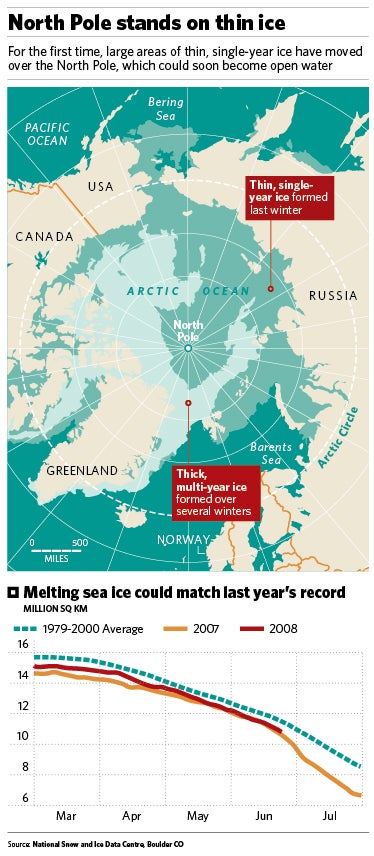Exclusive: Scientists warn that there may be no ice at North Pole this summer
Polar scientists reveal dramatic new evidence of climate change

It seems unthinkable, but for the first time in human history, ice is on course to disappear entirely from the North Pole this year.
The disappearance of the Arctic sea ice, making it possible to reach the Pole sailing in a boat through open water, would be one of the most dramatic – and worrying – examples of the impact of global warming on the planet. Scientists say the ice at 90 degrees north may well have melted away by the summer.
"From the viewpoint of science, the North Pole is just another point on the globe, but symbolically it is hugely important. There is supposed to be ice at the North Pole, not open water," said Mark Serreze of the US National Snow and Ice Data Centre in Colorado.
If it happens, it raises the prospect of the Arctic nations being able to exploit the valuable oil and mineral deposits below these a bed which have until now been impossible to extract because of the thick sea ice above.
Seasoned polar scientists believe the chances of a totally ice-free North Pole this summer are greater than 50:50 because the normally thick ice formed over many years at the Pole has been blown away and replaced by huge swathes of thinner ice formed over a single year.
This one-year ice is highly vulnerable to melting during the summer months and satellite data coming in over recent weeks shows that the rate of melting is faster than last year, when there was an all-time record loss of summer sea ice at the Arctic.
"The issue is that, for the first time that I am aware of, the North Pole is covered with extensive first-year ice – ice that formed last autumn and winter. I'd say it's even-odds whether the North Pole melts out," said Dr Serreze.
Each summer the sea ice melts before reforming again during the long Arctic winter but the loss of sea ice last year was so extensive that much of the Arctic Ocean became open water, with the water-ice boundary coming just 700 miles away from the North Pole.
The diminishing polar ice
Courtesy of NOAA / NESDIS Center for Satellite Applications and Research
This meant that about 70 per cent of the sea ice present this spring was single-year ice formed over last winter. Scientists predict that at least 70 per cent of this single-year ice – and perhaps all of it – will melt completely this summer, Dr Serreze said.
"Indeed, for the Arctic as a whole, the melt season started with even more thin ice than in 2007, hence concerns that we may even beat last year's sea-ice minimum. We'll see what happens, a great deal depends on the weather patterns in July and August," he said.
Ron Lindsay, a polar scientist at the University of Washington in Seattle, agreed that much now depends on what happens to the Arctic weather in terms of wind patterns and hours of sunshine. "There's a good chance that it will all melt away at the North Pole, it's certainly feasible, but it's not guaranteed," Dr Lindsay said.
The polar regions are experiencing the most dramatic increase in average temperatures due to global warming and scientists fear that as more sea ice is lost, the darker, open ocean will absorb more heat and raise local temperatures even further. Professor Peter Wadhams of Cambridge University, who was one of the first civilian scientists to sail underneath the Arctic sea ice in a Royal Navy submarine, said that the conditions are ripe for an unprecedented melting of the ice at the North Pole.
"Last year we saw huge areas of the ocean open up, which has never been experienced before. People are expecting this to continue this year and it is likely to extend over the North Pole. It is quite likely that the North Pole will be exposed this summer – it's not happened before," Professor Wadhams said.
There are other indications that the Arctic sea ice is showing signs of breaking up. Scientists at the Nasa Goddard Space Flight Centre said that the North Water 'polynya' – an expanse of open water surrounded on all sides by ice – that normally forms near Alaska and Banks Island off the Canadian coast, is much larger than normal. Polynyas absorb heat from the sun and eat away at the edge of the sea ice.
Inuit natives living near Baffin Bay between Canada and Greenland are also reporting that the sea ice there is starting to break up much earlier than normal and that they have seen wide cracks appearing in the ice where it normally remains stable. Satellite measurements collected over nearly 30 years show a significant decline in the extent of the Arctic sea ice, which has become more rapid in recent years.
Click here to watch a video on ways to reduce carbon emissions
Join our commenting forum
Join thought-provoking conversations, follow other Independent readers and see their replies
Comments